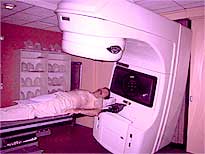 |
|
|
Radiotherapy is a medical speciality dedicated almost exclusively to patients with cancer. A precisely calculated dose of ionizing radiation<//lex>, usually gamma rays or X-rays is delivered to the tumour with minimal damage to neighbouring structures. Radioactive sources can either be swallowed to be used in contact with the tumour or used outside the body to emit rays that are focused by surgeons onto the tumour. If swallowed, the area in contact with the source receives a massive dose of radiation, sparing the adjacent tissues. The main sources of radiation in this case are Cs-137, Ir-192 or I-131. If used outside the body, the source emits radiation (gamma rays or X-rays) which reaches the tumor after travelling through different tissues. Usually several different sources whose rays converge on the target area are set up. Thus the target tumour receives the prescribed dose of radiation while the normal tissues in the surrounding regions receive a much lower dose. Surgeons and their patients have to weigh up the benefits of treatment against damage to surrounding tissue - see radiation and decision making for more information. |



 Ultrasound
Ultrasound
What's your opinion?
Average rating




Current rating: 3/5 (from 1 votes cast)